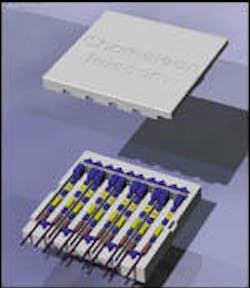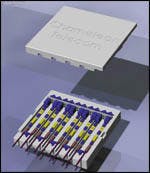New tunable-laser architecture targets the metro
By CAROLYN MATHAS
Today, approximately 17 companies dot the tunable-laser landscape, touting devices in various stages of development and availability. While tunable lasers promise to replace fixed-wavelength primary and spare lasers in long-haul systems, SRI International (Menlo Park, CA) believes the real opportunity lies in its delivery to the cost-sensitive metropolitan network segment. Given an industry rule-of-thumb, however, that tunable lasers can cost no more than 120% of fixed-wavelength lasers, SRI believes that few, if any, of the existing 17 players are able to adequately reign in costs from an existing 100% premium to an estimated 20% premium for use in the long-haul market and are far from meeting price targets necessary to sell into the metro space. SRI hopes to change all that.To help achieve that goal, SRI recently announced the availability of its Chameleon technology, an architecture that allows designers of nearly every tunable-laser technology to package lasers in a way that substantially reduces space and provides self-calibration and non-external stabilization, at a cost that SRI claims is 10 times lower than conventional solutions. The company plans to license the technology to interested tunable-laser developers.
"SRI saw a need for higher-performance and lower-cost lasers for metro WDM applications," says Pajo Vujkovic-Cvijin, senior research physician and primary inventor of the Chameleon technology. "Searching for a way to use lower-cost components and update laser performance in an original way, SRI took lasers that are not inherently stable in wavelengths or that are not widely tunable, added proprietary stabilization techniques and self-calibration capabilities, and arranged them in an array the size of a matchbook."
Delivering tunable lasers to the metro markets is expected to have many advantages such as providing dynamic bandwidth allocation, flexible routing of signals, and virtual private networks. SRI is convinced that the way to get there is not to package each laser individually and stabilize each laser independently, but to create an array of tunable lasers to achieve target price points.
The technology incorporates three critical elements: built-in stabilization, self-calibration, and the use of low-cost commercially available lasers. The combination of factors makes the solution less expensive than conventional lasers for metro service providers to deploy bandwidth over a certain nanometer range on the C-band. In licensing technology to bring the cost down to 10% of today's laser prices, SRI believes that the resulting price point is sufficiently low for tunable lasers to move into the metro.
Ricky Keang-Po Ho, chief technical officer of StrataLight Communications (Campbell, CA), agrees: "For the cost-sensitive market like metro WDM, the Chameleon laser technology may have an advantage. The availability of absolute wavelength reference in the same package is impressive, as is the wavelength accuracy of each laser. Packaging the array containing 10 lasers in the one package effectively lowers cost."
According to Philip von Guggenberg, director of business development at SRI, the typical stability of tunable lasers (the variation in wavelength or frequency of light emitted) is about 3 GHz for distributed Bragg reflector devices. If wavelength varies substantially, the variation must be accounted for before another wavelength is added. Also, added wavelengths cannot be placed too closely to avoid affecting the signal. By making stability tight, more wavelengths or channels can be added, ensuring full bandwidth. Based on a proprietary wavelength stabilization technique, von Guggenberg claims to have achieved a reduction to a fraction of 1 GHz.
Chameleon technology provides self-calibration of all of the lasers housed in the array as it boots up and locks them into a specific wavelength. "The cost of calibration is seldom isolated," says von Guggenberg. "SRI queried a tunable-laser company regarding the cost of one of their lasers without calibration. The answer: Their tunable laser would be approximately half-price if calibration weren't required. Self-calibration saves a wealth of time and money."
SRI claims that the technology works best with a large number of wavelengths. Based on the assumption that there should be at least eight wavelengths, and preferably 32, the Chameleon functional unit is an eight-laser array within a package the size of a flip matchbook. Each package contains eight active lasers and two spares. Currently, an eight-channel system occupies a full width of a 19-inch rack in a central office. Using two Chameleon matchbook devices replaces a total width of a 19-inch rack with a single line card-a significant space savings.
At the same time, Chameleon is said to not affect laser performance. An area of performance concern is power output. Chameleon does not tap into or siphon power from the primary power output, but instead uses the back facet light output to perform calibration and stabilization functions. If the laser output is set to 20 mW of power, it still outputs 20 mW of power using the Chameleon architecture.
SRI admits there is one laser technology (external-cavity lasers) that would pose a challenge-Fabry-Perot tunable lasers with an external-cavity device. The challenge would be to make the external structure fit into the miniature Chameleon packaging.

